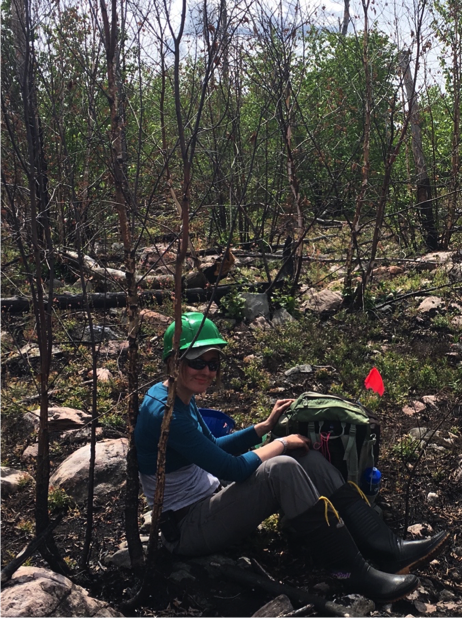As our 2016 field campaign comes to an end, I find myself proud of all the great data we collected. Our primary objective was to sample enough sites of different ages, land use, and species composition to be able to say something meaningful about changing fire regimes and the interactions between wildfire and timber harvest. I’m confident we accomplished this. In a way though, the work has just begun. Now we must conduct laboratory tests on many coolers worth of soil, count hundreds of tree rings, pour over the data, interpret the results, and write it up for publication. But none of this would be possible without collecting the amount of high-quality field data we did.

Catherine Dieleman, preparing to dig a soil core.
In fact, none of this would be possible without something much more fundamental: an amazing team. We came from Massachusetts, California, Ontario, and Belgium. We are at varying stages of our careers but were all excited to be there, with our hands in the dirt collecting data. We woke up early and got home late. Our bodies were sore. There were any number of cuts, scrapes, and bruises. We were always dirty, especially the days sampling burned forests when everything you touch is covered in soot and char. Bogs and rain made for wet boots and wet socks. Oh and the bugs. When the black flies and mosquitos began to relent they were replaced by deer and horse flies.
Each team member had their personal battles, their moments and days of drudgery. But they all found a way to power through. The only complaining I heard was in jest, to lighten the mood and make for a few laughs. And we had a lot of laughs. We thoroughly enjoyed each other’s company. Given the situation, having to work hard and spend every minute of the day together, I think that is a rare and wonderful thing.

Liz Wiggins and Jocelyne LaFlamme, packed up and ready to walk to the next field site.
Someday soon our plots will be boiled down to points on a map, or included in a model. Some will read and cite our papers, or use a figure in a presentation. Hopefully we will have made a valuable contribution to science, and to NASA’s ABoVE campaign. But only we know what each one of those plots felt like. The young pine forests thick with prickly brush. The old-growth pine and spruce that felt so majestic in comparison. The failed plots that never were. And that one where the ‘forest chicken’ attacked us. Or was it a mini-ostrich? Hard to say. (It was a grouse.)
Someone wise once told me you can teach science and you can teach methods. But you can’t teach attitude. A positive attitude will keep you afloat through the tough times and make you appreciate the good. A bad attitude will make everything difficult. Attitude is the primary quality I look for in team members, and boy did I luck out with this crew.
Thank you to my team for making this field campaign such a great success. Thank you Jill Johnstone and her crew for all their good will and hard work. Thank you Saskatchewan for being such a lovely host. And thank you NASA for giving us this opportunity.
Until next time. Rogers field team – over and out.
Brendan Rogers is a project lead with the ABoVE campaign, and an assistant scientist at the Woods Hole Research Center in Massachusetts.



